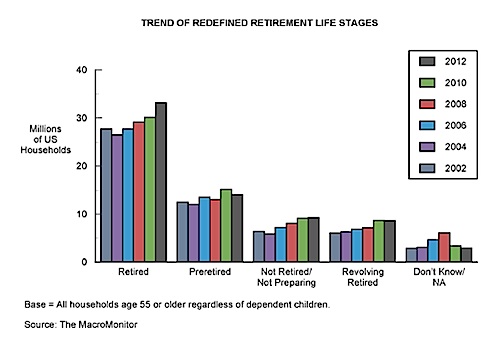Is there or isn’t there a retirement crisis in the United States? It depends on what you read, and which retirees or near-retirees you have in mind. Two recent reports by well-known organizations arrive at very different conclusions on the wellbeing of the American retirement system and American retirees.
On the one hand, a respected academic group, the Center of Retirement Research at Boston College, whose National Retirement Risk Index is sponsored by Prudential Financial, claims that more than half of American households are headed for a drop in living standards after they retire.
On the other hand, three retirement industry groups—the American Council of Life Insurers, the Investment Company Institute, and the American Benefits Council—just released a study claiming, “workers generally maintain their standard of living when they retire.”
How could two groups reach such different conclusions? Partly by using different data, partly by opting to favor averages over medians or vice-versa, and partly by having different goals: to shake up the status quo or to protect it.
The dim view
The Center for Retirement Research at Boston College, with funding from Prudential publishes an update of its National Retirement Risk Index every few years. It offers a rather grim view of Christmas Future for retirees.
In a recent study, “Will the Rebound in Equities and Housing Save Retirements?,” a CRR research team asserted that “half of today’s working age households are unlikely to have enough resources to maintain their standard of living once they retire.”
“As of 2010, even if households worked to the age of 65 and annuitized all their financial assets… 53% of American households were at risk,” wrote Alicia Munnell, Anthony Webb and Rebecca C. Fraenkel.
Despite the equity market’s rebound since 2010, the retirement outlook remains dire for many, the CRR believes. That’s because most people don’t own stocks and because home values—the basis for reverse mortgages, which are factored into the NRRI—are still depressed.
“While stocks are slightly higher than their pre-crisis peaks, house prices are still substantially lower in real terms than in 2007,” the CRR report said.
Stock ownership is also highly concentrated, so even an ongoing equity boom wouldn’t change the fact that more than half of today’s households won’t have enough resources to maintain their standard of living once they retire.
“Equities are only a miniscule amount of the wealth of low-income households and only % percent of the wealth of those in the middle- income group; only for the top third of the income distribution are equities a significant portion of total wealth.”
Evidently, if you have a large portfolio and a lot of home equity, you’re likely to be well prepared for retirement. For the rest, the best way out of this predicament is to save more and work longer, according to CRR.
The sunny view
And now, for something completely different.
A joint research report from the ABC, ACLI and the ICI had a decidedly rosier evaluation in a report that was largely a defense of the voluntary, tax-deferred employer-based retirement savings system, exemplified by the 401(k) plan.
Their report, Our Strong Retirement System: An American Success Story, found that Americans’ retirement prospects have improved greatly over time, with near-retirees averaging about $360,000 in their defined contribution and IRA assets.
The report found that retirement assets constitute a major share of household savings and investments, which it said speaks to the health of the investment industry, and investors’ confidence in the retirement system.
“The saving and investments held in the retirement system represent the largest component or share of American households’ total accumulated financial wealth,” said the report.
“At the end of June 2013, total retirement assets of $20.9 trillion, as tabulated by ICI, represented 34% of $61.9 trillion in all household financial assets in the United States.” Of that amount, about half is in employer-sponsored retirement plans and IRAs. The rest is in private defined pension plans, annuity reserves and government retirement plans.
Regarding the ability of savings to provide retirement income, the report cites Internal Revenue Service data showing that “income from wages, Social Security benefits, employer-sponsored retirement plans, and IRAs, net of taxes and adjusted for inflation, on average remains fairly stable in the year individuals first claim Social Security benefits and for three years thereafter. For three-quarters of these individuals, income in the year in which they retired equaled 87% or more of their income in the prior year.”
Why the difference?
It’s not easy to measure how well Americans in general are prepared for retirement, or what percentage of Americans are on track to be financially secure in retirement. There are blind spots and inconsistent benchmarks in the data. The definition of “Maintenance of pre-retirement standard of living” seems like a hard thing to gauge.
It’s easy to see, however, how two different organizations are able to find evidence that supports opposing conclusions about retirement readiness. It’s true that Americans as a whole have saved a lot for retirement and own a lot of securities, much of it through their 401(k) plans. It’s equally true that the savings is concentrated at the successful end of the income spectrum.
For example, the March 2013 National Compensation Survey showed that 59% of all full-time private industry workers were participating in a retirement plan. But only 20% of part-time workers were. Comparing union with non-union workers, the participation rates were 86% and 45%, respectively. Comparing the top 25% of earners with the bottom 25%, the numbers were 78% and 18%.
Like the person whose head is in the oven and feet are in the freezer, the U.S. body politic will have very different experiences in retirement. But, on average, you could say that we’re doing all right.
© 2013 RIJ Publishing LLC. All rights reserved.



 WHAT I DO: Dalbar has been characterized as a ‘policeman’ of the financial services community. There are three areas of service that we focus on. First, we’re well known for tracking investment behavior and activities related to financial services. Second, we perform qualitative and quantitative evaluations of business processes. The third area is certification. Our most closely followed report is the Quantitative Analysis of Investor Behavior, or QAIB. We do tracking reports for customer service, investor statements, websites and, most recently, for mobile devices. We’ve also issued reports covering fee disclosure, fiduciary changes, target date funds and asset allocation practices. As for our name, the ‘Dalbar’ brand name was arbitrarily invented. The name had to be unique, not offensive, not too long, not too short, easily spelled and pronounced.
WHAT I DO: Dalbar has been characterized as a ‘policeman’ of the financial services community. There are three areas of service that we focus on. First, we’re well known for tracking investment behavior and activities related to financial services. Second, we perform qualitative and quantitative evaluations of business processes. The third area is certification. Our most closely followed report is the Quantitative Analysis of Investor Behavior, or QAIB. We do tracking reports for customer service, investor statements, websites and, most recently, for mobile devices. We’ve also issued reports covering fee disclosure, fiduciary changes, target date funds and asset allocation practices. As for our name, the ‘Dalbar’ brand name was arbitrarily invented. The name had to be unique, not offensive, not too long, not too short, easily spelled and pronounced.

